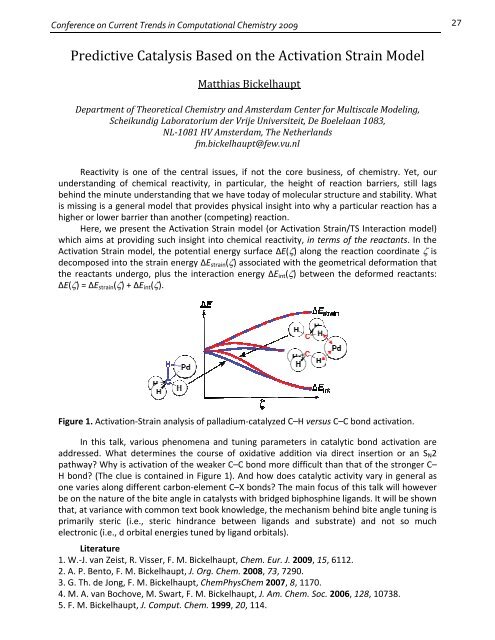Proceedings - Interdisciplinary Center for Nanotoxicity
Proceedings - Interdisciplinary Center for Nanotoxicity
Proceedings - Interdisciplinary Center for Nanotoxicity
Create successful ePaper yourself
Turn your PDF publications into a flip-book with our unique Google optimized e-Paper software.
Conference on Current Trends in Computational Chemistry 2009<br />
Predictive Catalysis Based on the Activation Strain Model<br />
Matthias Bickelhaupt<br />
Department of Theoretical Chemistry and Amsterdam <strong>Center</strong> <strong>for</strong> Multiscale Modeling,<br />
Scheikundig Laboratorium der Vrije Universiteit, De Boelelaan 1083,<br />
NL1081 HV Amsterdam, The Netherlands<br />
fm.bickelhaupt@few.vu.nl<br />
Reactivity is one of the central issues, if not the core business, of chemistry. Yet, our<br />
understanding of chemical reactivity, in particular, the height of reaction barriers, still lags<br />
behind the minute understanding that we have today of molecular structure and stability. What<br />
is missing is a general model that provides physical insight into why a particular reaction has a<br />
higher or lower barrier than another (competing) reaction.<br />
Here, we present the Activation Strain model (or Activation Strain/TS Interaction model)<br />
which aims at providing such insight into chemical reactivity, in terms of the reactants. In the<br />
Activation Strain model, the potential energy surface ∆E(ζ) along the reaction coordinate ζ is<br />
decomposed into the strain energy ∆Estrain(ζ) associated with the geometrical de<strong>for</strong>mation that<br />
the reactants undergo, plus the interaction energy ∆Eint(ζ) between the de<strong>for</strong>med reactants:<br />
∆E(ζ) = ∆Estrain(ζ) + ∆Eint(ζ).<br />
Figure 1. Activation‐Strain analysis of palladium‐catalyzed C–H versus C–C bond activation.<br />
In this talk, various phenomena and tuning parameters in catalytic bond activation are<br />
addressed. What determines the course of oxidative addition via direct insertion or an SN2<br />
pathway? Why is activation of the weaker C–C bond more difficult than that of the stronger C–<br />
H bond? (The clue is contained in Figure 1). And how does catalytic activity vary in general as<br />
one varies along different carbon‐element C–X bonds? The main focus of this talk will however<br />
be on the nature of the bite angle in catalysts with bridged biphosphine ligands. It will be shown<br />
that, at variance with common text book knowledge, the mechanism behind bite angle tuning is<br />
primarily steric (i.e., steric hindrance between ligands and substrate) and not so much<br />
electronic (i.e., d orbital energies tuned by ligand orbitals).<br />
Literature<br />
1. W.‐J. van Zeist, R. Visser, F. M. Bickelhaupt, Chem. Eur. J. 2009, 15, 6112.<br />
2. A. P. Bento, F. M. Bickelhaupt, J. Org. Chem. 2008, 73, 7290.<br />
3. G. Th. de Jong, F. M. Bickelhaupt, ChemPhysChem 2007, 8, 1170.<br />
4. M. A. van Bochove, M. Swart, F. M. Bickelhaupt, J. Am. Chem. Soc. 2006, 128, 10738.<br />
5. F. M. Bickelhaupt, J. Comput. Chem. 1999, 20, 114.<br />
27



